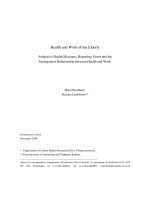Handbook of health social work 1
Bạn đang xem bản rút gọn của tài liệu. Xem và tải ngay bản đầy đủ của tài liệu tại đây (7.26 MB, 998 trang )
Praise for Handbook of Health Social Work, Second Edition
“The major strength is the organization and comprehensive content of the book. This is a book that
can serve as a reference book in any social worker’s library, regardless of whether they are practicing in a health-care setting. There are no other books on this topic that are as comprehensive in
scope as the Handbook of Health Social Work, Second Edition.”
—Deborah Collinsworth, LAPSW, NSW-C,
Director of Nephrology Social Work Services,
Dialysis Clinics, Inc., West Tennessee
“I’m quite impressed by the comprehensive nature of this revision. It’s the enduring kind of text
that serves an immediate purpose for social work instruction while also providing a reference for
future practice. This is a book that you’ll want to keep on your shelf.”
—Kevin Lindamood,
Vice President for External Affairs at Health Care for the Homeless,
Adjunct Professor of Health Policy at the University of Maryland SSW
“Sarah Gehlert and Teri Browne have thoughtfully covered the topics. The readers of this book
will be empowered to deal with the daily challenges. It’s simple but far reaching, a rich knowledge
bank of social workers’ interventions, and will benefit even policy makers in planning strategies to
improve patients’ quality of life.”
—Sujata Mohan Rajapurkar, PhD,
Medical Social Worker and Transplant Coordinator,
Muljibhai Patel Urological Hospital, Gujarat, India
“The book’s strengths include the high quality of writing and the expertise of its contributors. It
covers the field of health social work in significant depth and is sure to leave readers well
informed.”
—Mary Sormanti, PhD, MSW,
Associate Professor of Professional Practice,
Columbia University School of Social Work
“Quite simply, this is the definitive volume for Health and Social Work. The first edition was wellexecuted, well-written, and comprehensive. In this second edition, Gehlert and Browne and their
expert contributors have confidently managed to keep pace with current theory and empirical research across a wide range of subject matter that will be of interest to practitioners, educators, and
researchers.”
—Michael Vaughn, PhD,
Assistant Professor, School of Social Work,
School of Public Health,
and Department of Public Policy Studies, Saint Louis University
HANDBOOK OF HEALTH
SOCIAL WORK
SECOND EDITION
Edited by
SARAH GEHLERT and
TERI BROWNE
John Wiley & Sons, Inc.
This book is printed on acid-free paper. o
Copyright © 2012 by John Wiley & Sons, Inc. All rights reserved.
Published by John Wiley & Sons, Inc., Hoboken, New Jersey.
Published simultaneously in Canada.
No part of this publication may be reproduced, stored in a retrieval system, or transmitted in any form or by any means,
electronic, mechanical, photocopying, recording, scanning, or otherwise, except as permitted under Section 107 or 108
of the 1976 United States Copyright Act, without either the prior written permission of the Publisher, or authorization
through payment of the appropriate per-copy fee to the Copyright Clearance Center, Inc., 222 Rosewood Drive, Danvers,
MA 01923, (978) 750-8400, fax (978) 646-8600, or on the Web at www.copyright.com. Requests to the Publisher for
permission should be addressed to the Permissions Department, John Wiley & Sons, Inc., 111 River Street, Hoboken, NJ
07030, (201) 748-6011, fax (201) 748-6008.
Limit of Liability/Disclaimer of Warranty: While the publisher and author have used their best efforts in preparing this
book, they make no representations or warranties with respect to the accuracy or completeness of the contents of this book
and specifically disclaim any implied warranties of merchantability or fitness for a particular purpose. No warranty may be
created or extended by sales representatives or written sales materials. The advice and strategies contained herein may not
be suitable for your situation. You should consult with a professional where appropriate. Neither the publisher nor author
shall be liable for any loss of profit or any other commercial damages, including but not limited to special, incidental,
consequential, or other damages.
This publication is designed to provide accurate and authoritative information in regard to the subject matter covered. It
is sold with the understanding that the publisher is not engaged in rendering professional services. If legal, accounting,
medical, psychological or any other expert assistance is required, the services of a competent professional person should
be sought.
Designations used by companies to distinguish their products are often claimed as trademarks. In all instances where John
Wiley & Sons, Inc. is aware of a claim, the product names appear in initial capital or all capital letters. Readers, however,
should contact the appropriate companies for more complete information regarding trademarks and registration.
For general information on our other products and services, please contact our Customer Care Department within the U.S.
at (800) 762-2974, outside the United States at (317) 572-3993 or fax (317) 572-4002.
Wiley also publishes its books in a variety of electronic formats. Some content that appears in print may not be available
in electronic books. For more information about Wiley products, visit our Web site at www.wiley.com.
Library of Congress Cataloging-in-Publication Data:
Handbook of health social work / edited by Sarah Gehlert and Teri Browne. — 2nd ed.
p. cm.
Includes bibliographical references and index.
ISBNs 978-0-470-64365-5; 978-1-118-11589-3; 978-1-118-11591-6; 978-118-11590-9
1. Medical social work—Handbooks, manuals, etc.
I. Gehlert, Sarah, 1948II. Browne, Teri.
HV687.A2H36 2012
362.1‘0425—dc22
2011010997
Printed in the United States of America
10 9 8 7 6 5 4 3 2 1
Contents
Foreword viii
Suzanne Heurtin-Roberts
Acknowledgments x
List of Contributors xi
Introduction xiii
PART I
FOUNDATIONS OF SOCIAL WORK IN HEALTH CARE
1⏐ Conceptual Underpinnings of Social Work in Health Care 3
Sarah Gehlert
2⏐ Social Work Roles and Health-Care Settings 20
Teri Browne
3⏐ Ethics and Social Work in Health Care 41
Jared Sparks
4⏐ Public Health and Social Work 64
Marjorie R. Sable, Deborah R. Schild, and J. Aaron Hipp
5⏐ Health Policy and Social Work 100
Julie S. Darnell and Edward F. Lawlor
6⏐ Theories of Health Behavior 125
Sarah Gehlert and Sarah E. Bollinger
v
1
vi Contents
PART II HEALTH SOCIAL WORK PRACTICE: A SPECTRUM OF CRITICAL
CONSIDERATIONS 141
7⏐ Community and Health 143
Christopher Masi
8⏐ Physical and Mental Health: Interactions, Assessment, and Interventions 164
Malitta Engstrom
9⏐ Social Work Practice and Disability Issues 219
Rebecca Brashler
10⏐ Communication in Health Care 237
Sarah Gehlert
11⏐ Religion, Spirituality, Health, and Social Work 263
Terry A. Wolfer
12⏐ Developing a Shared Understanding: When Medical Patients Use
Complementary and Alternative Approaches 291
Penny B. Block
13⏐ Families, Health, and Illness 318
John S. Rolland
14⏐ Human Sexual Health 343
Les Gallo-Silver and David S. Bimbi
PART III
HEALTH SOCIAL WORK: SELECTED AREAS OF PRACTICE
371
15⏐ Social Work With Children and Adolescents With Medical Conditions 373
Nancy Boyd Webb and Rose A. Bartone
16⏐ Social Work With Older Adults in Health-Care Settings 392
Sadhna Diwan, Shantha Balaswamy, and Sang E. Lee
17⏐ Substance Use Problems in Health Social Work Practice 426
Malitta Engstrom, Colleen A. Mahoney, and Jeanne C. Marsh
Contents vii
18⏐ Nephrology Social Work 468
Teri Browne
19⏐ Oncology Social Work 498
Daniel S. Gardner and Allison Werner-Lin
20⏐ Adherence and Mental Health Issues in Chronic Disease: Diabetes, Heart
Disease, and HIV/AIDS 526
Wendy Auslander and Stacey Freedenthal
21⏐ Social Work and Genetics 557
Allison Werner-Lin and Kate Reed
22⏐ Pain Management and Palliative Care 590
Terry Altilio, Shirley Otis-Green, Susan Hedlund, and Iris Cohen Fineberg
23⏐ End-of-Life Care 627
Yvette Colón
Afterword 643
Candyce S. Berger
About the Editors 649
Author Index 651
Subject Index
677
Foreword
It is both an exciting and a challenging time
to be a social worker in the field of health. A
diversity of roles is available for social workers. Areas of practice and opportunities for
inter- and transdisciplinary collaborations are
unprecedented in the history of the profession.
Social workers along with other professionals
are on the cutting edge of new health-relevant
programs and practices, with social workers
frequently in top leadership roles in these efforts. To note just a very few examples, social
workers are providing genetic counseling and
mental health treatment, coordinating hospice
and palliative care, working with communities
to develop better access to cancer care and
clini- cal trials, advocating for and writing
improved health-relevant policies, developing
health pro- grams and practices, and
conducting research that provides an evidence
base for effective practice in social work and
other professions.
A number of events and trends have come
to bear on this blossoming of social work in
health. The Patient Protection and Affordable
Care Act of 2010 (PPACA), itself the result of
decades of advocacy and study on the part of
many, including social workers, will radically
change the context in which health care is delivered in the United States. This change will
require profound and unsurpassed expertise
in complex systems and their relationships to
users of health care that is the domain of social workers. Effective implementation of the
PPACA will require social work expertise at
all levels, from front-line practitioner to policy
maker and executive.
The evidence-based practice movement in
social work and other health professions also
has been integral to the rising importance of
social work in health. From first-level, or T1,
translation of research findings to cultural and
community tailoring and dissemination and
diffusion, social work has a principal role to
play in getting health knowledge and knowledge-based practice to the populations that
most can use it. Indeed, social work has been
and will continue to be a key source of
research producing such knowledge. As the
profession is focused on improving people’s
well-being through practice that targets
interrelationships among systems and people,
social work re- search is of great consequence
for knowledge production on which to base
health-care re- form and other efforts to
improve health care in the United States.
Thanks to the concerted and strategic efforts
of academic social work and professional
social work organizations, health social work
research is growing and be- ginning to
flourish.
The growth of the social determinants perspective on health has fostered a crucial place
for social work in health. As a profession, social work has long understood the importance
of multiple life dimensions and experiences as
they affect human well-being across the life
cycle and has built its practice on such a perspective. As other health professions catch up
in this area, social work’s contributions can be
very influential in helping to prevent reinvention of the wheel in both health care and disease prevention.
viii
Foreword ix
I have noted just a few of the phenomena
leading to social work’s rich contributions to
health and great potential for even more. As a
postdoctoral fellow in applied anthropology, I
once worked in a hospital setting on a
geriatric consult team. Repeatedly I went to
social work staff for information and advice.
Indeed, my team (which included physicians,
a nurse, and a pharmacologist) held to the
mantra of “go ask a social worker, they know
everything!” The breadth and depth of social
work exper- tise in health is reflected in and
supported by the material in the current work.
This volume is a crucial addition to the
libraries of seasoned practitioners as well as
an essential foundation for fledgling social
workers ready to enter health as a practice
and research area. Both editors are respected
leaders in the field of health and social work
with an abundance of experience, knowledge,
and passion for their work. They have brought
together a multiplicity of impressive contributors, all authorities in their respective areas,
who share their knowledge and wisdom. The
Handbook’s contributors address multiple
theoretical foundations, models, issues, and
dilemmas for the social worker in health.
Included are descriptions of skill sets and
other expertise needed for direct practice
clinicians, community workers, planners,
policy makers, researchers, advocates, and
administrators. The volume covers practice
and research areas ranging from chronic
disorders to infectious disease, from physical
to mental disorders, and all the gray areas in
between.
However, the book is not simply a how-to
manual. Rather, it assesses the current state
of the field while suggesting important new
directions and developments for the future of
social work in health. The ideas in this volume suggest that, perhaps, there is some truth
to the sentiment that “social workers know
everything.” Certainly they know a great deal
about working to improve health and about
what will be needed in the future to improve
the nation’s health. At a time of great change
in the United States in regard to facilitating
the production of better health for populations
and individuals, any social worker engaged in
this area would be well advised to have this
out- standing resource at hand.
Suzanne Heurtin-Roberts
Bethesda, Maryland
Acknowledgments
The preparation of the second edition of this
Handbook involved the efforts of a number of
people. First and foremost was Jerrod Liveoak, a very talented young man who again
helped us organize and edit the Handbook. We
could not have done it without his assistance. Rachel Livsey and Kara Borbely of
John Wiley & Sons’ behavioral science division were supportive throughout the process.
We join them in mourning the loss of Lisa
Gebo, a gifted member of the John Wiley
& Sons team who worked with us on the
first edition and lost her life to breast cancer on June 14, 2010. We also would like
to thank these colleagues who reviewed the
book and provided valuable feedback: Gary
Rosenberg, Mount Sinai School of Medicine;
Mary Sormanti, Columbia University; Judy
Howe, Mount Sinai School of Medicine;
Kevin Lindamood, University of Maryland;
Deborah Collinsworth, Union University;
and Michael Vaughn, St. Louis University.
The 36 contributors to the Handbook, some
of whom were friends and others known to
us only by reputation prior to the collaboration, worked hard and were patient with this
revision. Finally, we would like to thank our
spouses, Roy Wilson and Lyle Browne, who
were always willing to listen to our ideas and
to provide feedback and support.
x
List of Contributors
Terry Altilio, MSW, ACSW
Beth Israel Medical Center
New York, New York
Yvette Colón, PhD, ACSW, BCD
American Pain Foundation
Baltimore, Maryland
Wendy Auslander, PhD
Washington University
St. Louis, Missouri
Julie S. Darnell, PhD
University of Illinois at Chicago
Chicago, Illinois
Shantha Balaswamy, PhD
Ohio State University
Columbus, Ohio
Sadhna Diwan, PhD
San Jose State University
San Jose, California
Rose A. Bartone, MSW, LCSW-R
New York Medical College
Valhalla, New York
Malitta Engstrom, PhD
University of Chicago
Chicago, Illinois
Candyce S. Berger, PhD
Stony Brook University
Stony Brook, New York
Iris Cohen Fineberg, PhD
Lancaster University
Lancaster, United Kingdom
David S. Bimbi, PhD
LaGuardia Community College
Long Island City, New York
Stacey Freedenthal, PhD
University of Denver
Denver, Colorado
Penny B. Block, PhD
Block Center for Integrative Cancer Care
Evanston, Illinois
Les Gallo-Silver, MSW, ACSW, CSW-R
LaGuardia Community College
Long Island City, New York
Sarah E. Bollinger, MSW, LCSW
Washington University
St. Louis, Missouri
Daniel S. Gardner, PhD
New York University
New York, New York
Rebecca Brashler, MSW, LCSW
Rehabilitation Institute of Chicago
Chicago, Illinois
Sarah Gehlert, PhD
Washington University
St. Louis, Missouri
Teri Browne, PhD
University of South Carolina
Columbia, South Carolina
Susan Hedlund, MSW, LCSW
Hospice of Washington County
Portland, Oregon
xi
Suzanne Heurtin-Roberts, PhD, MSW
United States Department of Health and
Human Services
Bethesda, Maryland
J. Aaron Hipp, PhD
Washington University
St. Louis, Missouri
Edward F. Lawlor, PhD
Washington University
St. Louis, Missouri
Sang E. Lee, PhD
San Jose State University
San Jose, California
Colleen A. Mahoney, PhD
University of Wisconsin
Madison, Wisconsin
Jeanne C. Marsh, PhD
University of Chicago
Chicago, Illinois
Christopher Masi, MD, PhD
University of Chicago
Chicago, Illinois
Shirley Otis-Green, MSW, ACSW, LCSW
City of Hope National Medical Center
Duarte, California
Kate Reed, MPH, ScM
National Coalition for Health Professional
Education in Genetics
Lutherville, Maryland
John S. Rolland, MD
Chicago Center for Family Health
Chicago, Illinois
Marjorie R. Sable, DrPH
University of Missouri
Columbia, Missouri
Deborah R. Schild, PhD
Public Health Social Worker
Ann Arbor, Michigan
Jared Sparks, PhD
Ozark Guidance
Springdale, Arkansas
Nancy Boyd Webb, DSW, LICSW, RPT-S
Fordham University (retired)
New York, New York
Allison Werner-Lin, PhD
New York University
New York, New York
Terry A. Wolfer, PhD
University of South Carolina
Columbia, South Carolina
Introduction
In a faculty meeting a few years ago, a colleague from another profession referred to the
“lower-level skills” of social workers in health
care. She distinguished these skills from the
“higher-level skills” of social workers in mental health settings. I addressed her comment
by citing the broad array of information that
social workers in health care must possess and
be able to access quickly in order to assess client situations and devise optimal plans in the
limited time available to them in health-care
settings. I characterized the process as highly
challenging, requiring skills at least as well
developed as those of social workers in other
arenas. This exchange between my colleague
and me made me realize two things. First of
all, health social work is not well understood
by those working in other subfields of social
work and other disciplines. Second, it would
behoove health social work scholars to better
define and represent the subfield.
As health care becomes increasingly more
complex, social workers have much to know.
We have yet to fully understand what the Patient Protection and Affordable Care Act that
was enacted in March 2010 means for the
health of the nation or what it means for social work practice and research. We do know
that current federal approaches to addressing
complicated health conditions like HIV/AIDS
and cancer argue strongly for simultaneous
attention to factors operating at the social,
psychological, and biological levels (see, e.g.,
Warnecke et al., 2008). As members of healthcare teams that take these approaches, social
workers must possess sufficient knowledge at
the social, psychological, and biological levels to converse productively with other team
members and to work in concert with them
constructively. In addition, to be effective, social workers must be aware of how these factors operate with individuals, families, groups,
communities, and societies. This awareness is
best accomplished by engaging community
stakeholders at many levels in research.
The Handbook of Health Social Work was
developed to prepare students to work in the
current health-care environment in which
providers from a number of disciplines work
more closely together than was ever the case
in the past. Health care in the United States
has moved from being multidisciplinary to
being interdisciplinary, with the ultimate
goal of being transdisciplinary. In multidisciplinary environments, professionals from different disciplines work on the same projects
but speak their own languages, view health
care through their own disciplinary lens, and
often share knowledge with one another after
the fact. Interdisciplinary teams interact more
closely, but each discipline continues to operate within its own boundaries. Because an
interdisciplinary approach almost never provides a broad enough view of health-care
conditions to capture their inherent complexities, transdisciplinary teamwork has become
the exemplar. Here health-care professionals
work so closely together that they must develop a shared language and pool the best of
their separate disciplinary theories. Absent this
xiii
Introduction xv
new, more interdependent approach, the team
is reminiscent of the old cartoon of a roomful
of blindfolded people touching different parts
of an elephant, with each describing the beast
based only on the part that she is touching.
One might base his description on the trunk,
another on the ears, and a third on the tail. To
address complex health conditions like HIV/
AIDS effectively, we must recognize the elephant in the room.
In 2009, my coeditor, Teri Browne, and I
were asked by John Wiley & Sons if we
would be interested in revising the Handbook.
A good deal has changed on both the national
and in- ternational fronts in the 4 years since
the first edition was published. The mapping
of the human genome in 2004 continues to
change how we view and approach the
treatment of disease. Our ability to treat some
disorders has increased markedly. Over the
four years be- tween the first and second
editions, increasing numbers of people lost
their health-care cov- erage. Although healthcare reform holds the potential to ensure that
citizens have cover- age, this is not true for
those who are undocu- mented immigrants,
and exactly how reform will impact the
nation’s steadily increasing health disparities
remains a question.
These changes will continue, and require a
great deal of flexibility on the part of health
so- cial workers. As was the case with the first
edi- tion of the Handbook of Health Social
Work, the second edition considers social
workers in health care to be active problem
solvers who must draw from a variety of
germane bodies of information to address the
issues and prob- lems faced by individuals,
families, groups, communities, and societies.
We believe that this approach allows
flexibility and thus posi- tions health social
workers to deal optimally with a changing
health-care environment. The authors and
layout of the second edition re- flect this
approach. Learning exercises at the end of
each chapter are designed to stimulate
discussion and help readers process the information provided and consider it analytically.
The book’s chapters are sandwiched between
a foreword by Suzanne Heurtin-Roberts and
an afterword by Candyce Berger, both of
whom
xiv Introduction
have broken ground as social work
leaders in health-care practice and
research and done much to raise the
profile of the profession.
The book is divided into three
sections. Part I, Foundations of
Social Work in Health Care,
provides information that we
consider basic and central to the
operations of social workers in
health care. In Chapter 1,
“Conceptual Un- derpinnings of
Social Work in Health Care,” Sarah
Gehlert again discusses the
principles that underlie the
development of social work in
health care and follows its course
through time to discover any
changes in principles and activities
that may have occurred. Chapter
2, “Social Work Roles and HealthCare Set- tings,” by Teri Browne,
carefully outlines the wide array of
roles performed by social work- ers
in health-care settings today. After
provid- ing a framework for ethical
decision making, Chapter 3, “Ethics
and Social Work in Health Care,” by
Jared Sparks, again considers some
key issues confronting social
workers in health care in a variety of
arenas, from practice with
individuals to policy development.
All three chapters take into account
the unique chal- lenges facing health
care in the United States. Public
health social work recently was
named as one of the top 50
professions by U.S. News & World
Report, and training programs that
combine the two continue to grow.
Be- cause of this, and because social
work has for a long time played an
integral role in the pub- lic health
of the United States and other parts
of the world, Chapter 4, titled
“Public Health and Social Work,” is
an essential component of the
Handbook, to orient readers to the
pub- lic health perspective. J.
Aaron Hipp, a com- munity
psychologist who works in a school
of public health, joined health
social workers Marjorie R. Sable and
Deborah R. Schild in revising the chapter.
The chapter introduces readers to the
concepts of primary, secondary, and tertiary
health care and considers health from a
wider lens than is often used, including global
patterns of health and disease. Chapter 5,
“Health Policy and Social Work,” written by
Julie S. Darnell and Edward F. Lawlor, is
almost totally revised from the first edition.
It presents basic information on the interplay
among clinical, administrative, and policy issues in health care. Although it is beyond the
scope of this book to cover all possible health
policies and considerations, an overview of
the most pertinent policies and issues is provided. The authors address the likely sequelae
of health care reform. Chapter 6, “Theories of
Health Behavior,” by Sarah Gehlert and Sarah
E. Bollinger, outlines five key theories and
meth- ods that can help guide social work
practice and research in health care. Empirical
evidence for their use in certain situations is
provided.
Part II is titled Health Social Work Practice: A Spectrum of Critical Considerations.
Although cases and questions confronted by
social workers in health care vary widely,
certain critical issues should always be considered. The eight chapters in this part represent critical issues that should be considered
in approaching cases or pursuing the answers
to health-care questions, even though in time
they may not prove to be germane to those
cases or questions. Failing to consider issues
such as religion, sexuality, or substance use
may lead to incomplete understandings of
cases or consideration of health-care questions. It was only after considering health
beliefs, for instance, that Matsunaga and colleagues (1996) were able to understand why
native Hawaiian women did not participate in
breast cancer screening despite their high rates
of breast cancer.
Because individuals and families do not
operate independently but rather as parts of
communities, an overview of the relationships
between health and community factors is included in Part II. In Chapter 7, “Community
and Health,” Christopher Masi again reviews
significant evidence-based data and provides
information about how knowledge about community factors can be accessed and included
in social work activities in health care. The
complex interplay of physical and mental
health is addressed in Chapter 8, “Physical
and Mental Health: Interactions, Assessment,
and Interventions.” The chapter, again
prepared by Malitta Engstrom, carefully
outlines how to assess for mental health
concerns and re- views a variety of
interventions. In Chapter 9,
“Social Work Practice and Disability Issues,”
Rebecca Brashler again carefully frames social work practice with individuals and groups
with disabilities and provides suggestions for
practice. Because communication is central
to the effective provision of heath care as it
changes through time, the revised chapter
titled “Communication in Health Care” is included as Chapter 10 in Part II of this Handbook. The chapter provides a basic framework
for understanding the dynamics of health-care
communication; reviews interventions for improving communication; considers the effect
of culture, gender, race, and other salient
factors on patient and provider
communication; and provides guidelines for
the use of interpreters. It also addresses the
dynamics of health-care teams and social
workers’ positions on teams. In Chapter 11,
“Religion, Spirituality, Health, and Social
Work,” author Terry A. Wolfer, who is new to
the Handbook, reviews the ways in which
religion and spirituality af- fect health and
individual and group responses to health care.
Ways of incorporating religious and spiritual
considerations into practice and policy are
reviewed. Complementary and al- ternative
treatments are reviewed in Chapter 12,
“Developing a Shared Understanding: When
Medical Patients Use Complementary and
Alternative Approaches.” Author Penny B.
Block provides information on the extent of
al- ternative and complementary treatments in
the United States and reasons for their use.
She reviews a number of treatments and their
his- tories and addresses the importance for
social workers of being familiar with
complementary and alternative techniques.
Chapter 13, “Fami- lies, Health, and Illness,”
again written by John
S. Rolland, presents a framework for understanding the interplay between family structure and dynamics and health and addresses
its implications for social work practice and
policy in health care. Chapter 14, “Human
Sexual Health,” addresses the relationship between sexuality and health and discusses ways
to incorporate sexual and other intimate considerations into practice and policy. Authors
Les Gallo-Silver and David S. Bimbi make
the point that sexual and other intimate issues
are
Introduction xvii
more likely to be faced by social workers in
health care than in other areas of practice.
Part III, Health Social Work: Selected
Areas of Practice, contains nine chapters by
social workers with extensive practice and
academic experience. Selecting the areas to
include was difficult, and the list is not meant
to be exhaus- tive. Our aim was to present a
range of examples of good social work
practice in sufficient detail to provide a
reasonable overview of social work practice in
health care. The second edition of the
Handbook includes a new chapter devoted to
health social work practice with young patients: Chapter 15, “Social Work With
Children and Adolescents With Medical
Conditions,” by seasoned authors Nancy Boyd
Webb and Rose
A. Bartone. Chapter 16, “Social Work With
Older Adults in Health-Care Settings,” outlines
the issues central to practice with older adults
and the challenges faced by social workers.
Sang E. Lee joins Sadhna Diwan and Shantha
Balaswamy as an author of the revised chapter. Because substance use is widespread today
and can negatively affect health and response
to treatment, it is important that social workers
consider the topic in practice and policy. The
revised Chapter 17, titled “Substance Use
Prob- lems in Health Social Work Practice,”
again written by Malitta Engstrom, Colleen A.
Mahoney, and Jeanne C. Marsh, carefully outlines the importance of considering substance
use and abuse and provides guidelines for incorporation into practice and policy.
After providing background on end-stage
renal disease and its psychosocial sequelae, in
Chapter 18, “Nephrology Social Work,” Teri
Browne reviews evidence-based social work
interventions, policies and programs, and
resources and organizations available to nephrology social workers. In Chapter 19, “Oncology Social Work,” Daniel S. Gardner joins
Allison Werner-Lin as an author in the revised
chapter. The chapter reviews psychosocial issues faced by patients with cancer and their
families. Practice considerations are outlined
and suggestions for interventions provided.
Issues of chronic illness are addressed by
Wendy Auslander and Stacey Freedenthal in
the revised and retitled Chapter 20, “Adher-
ence and Mental Health Issues in Chronic
Disease: Diabetes, Heart Disease, and HIV/
AIDS.” Chronic conditions present a number
of unique challenges to social workers, such
as how to improve adherence to treatment
recommendations. The authors outline these
challenges and make suggestions for practice.
Chapter 21, “Social Work and Genetics,” has
been revised in light of myriad advances in
our understanding of genetics and health that
have occurred in the last several years. Kate
Reed, from the National Coalition for Health
Pro- fessional Education in Genetics, joins
Allison Werner-Lin as an author of the
chapter, which considers the role of social
workers in helping patients and families learn
and make decisions about genetic testing and
cope with its results. The management of pain
in acute and chronic illness increasingly has
become the domain of social workers in
health care. Chapter 22, “Pain Management
and Palliative Care,” orients readers to the
effect of pain on behavior and functioning
and reviews roles for social workers in pain
management and palliative care teams. Terry
Altilio, Shirley Otis-Green, Susan Hedlund,
and Iris Cohen Fineberg are authors of the
chapter. Finally, Chapter 23, “End-of-Life
Care,” again by Yvette Colón, discusses how
social workers can assist patients and families
in dealing with
these end-of-life issues effectively.
Our aim in preparing the Handbook of
Health Social Work has been to provide a
source of information that would help social
workers to be active problem solvers rather
than followers of routines and existing protocols. The book enables social work students to
learn the foundations of practice and policy in
health care (Part I), critical considerations in
implementing practice and policy (Part II),
and the ways in which social work is practiced
in a number of arenas and with a number of
health conditions (Part III).
We hope that the book will continue to be
useful in professional education, allowing those
already in practice to learn about issues such as
pain management and alternative and complementary medicine that they might not have
been exposed to while in school or had the
xvi Introduction
opportunity
to learn after graduation. It also is a valuable
source of information on evidence-based practice in a variety of areas of health care.
Social workers in health care today face a
number of challenges, some new and some
that have always been with the profession. We
hope that readers will use the 23 chapters of
the Handbook of Health Social Work as a set
of tools to help them better address the healthcare needs of the individuals, families, groups,
com- munities, and societies with whom they
work.
Sarah Gehlert
St. Louis, Missouri
Teri Browne
Columbia, South Carolina
REFERENCES
Matsunaga, D. S., Enos, R., Gotay, C. C., Banner, R.
O., DeCambra, H., Hammond, O. W., . . . Tsark, J.
(1996). Participatory research in a native Hawaiian
community: The Wai’anae Cancer Research Project.
Cancer, 78, 1582–1586.
Warnecke, R. B., Oh, A., Breen, N., Gehlert, S., Lurie, N.,
Rebbeck, T., . . . Patmios, G. (2008). Approaching
health disparities from a population perspective:
The NIH Centers for Population Health and Health
Disparities. American Journal of Public Health, 98,
1608–1615.
PART I
Foundations of Social Work
in Health Care









